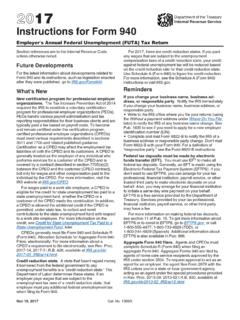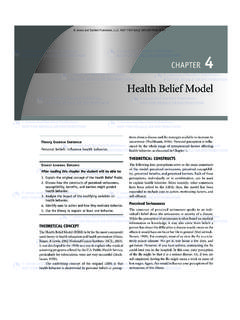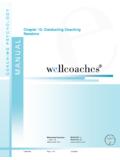Transcription of for Education Page 1 of 87 10:40 - 31-Jan-2018 Tax …
1 Userid: CPMS chema: tipxLeadpct: 100%Pt. size: 10 Draft Ok to PrintAH XSL/XMLF ileid: .. tions/P970/2017/A/XML/Cycle03/source(Ini t. & Date) _____Page 1 of 87 10:40 - 31-Jan-2018 The type and rule above prints on all proofs including departmental reproduction proofs. MUST be removed before of the TreasuryInternal Revenue ServicePublication 970 Cat. No. 25221 VTax Benefits for EducationFor use in preparing2017 ReturnsGet forms and other information faster and easier at: (English) (Espa ol) ( ) ( ) (Pусский) (Ti ngVi t) ContentsFuture 's 1. Scholarships, Fellowship Grants, Grants, and Tuition and Fellowship Types of Educational 2. American Opportunity You Claim the Credit?..11 What Expenses Qualify?..13 Who Is an Eligible Student?..17 Who Can Claim a Dependent's Expenses?..19 Figuring the the 3. Lifetime Learning You Claim the Credit?..23 What Expenses Qualify? ..24 Who Is an Eligible Student? ..28 Who Can Claim a Dependent's Expenses? ..29 Figuring the the 4.
2 Student Loan Interest Loan Interest You Claim the Deduction?..34 Figuring the the 5. Student Loan Cancellations and Repayment Loan Loan Repayment 6. Tuition and Fees 7. Coverdell Education Savings Account (ESA)..38 What Is a Coverdell ESA?.. and Other 8. Qualified Tuition Program (QTP)..50 What Is a Qualified Tuition Program?..50 How Much Can You Contribute?..51 Recontribution of Refunded Distributions Taxable?..51 Rollovers and Other 9. Education Exception to Additional Tax on Early IRA Is Eligible?..54 Jan 31, 2018 Page 2 of 87 Fileid: .. tions/P970/2017/A/XML/Cycle03/source10:4 0 - 31-Jan-2018 The type and rule above prints on all proofs including departmental reproduction proofs. MUST be removed before the Amount Not Subject to the 10% Early 10. Education Savings Bond Can Cash in Bonds Tax Free?..56 Figuring the Tax-Free the 11. Employer- Provided Educational 12. Business Deduction for Work-Related Work-Related Expenses Can Be Deducted?
3 62 How To Treat Business 13. How To Get Tax DevelopmentsFor the latest information about developments related to Pub. 970, such as legislation enacted after it was published, go to 's NewEducational institution's EIN required. To claim the American opportunity credit, you must provide the educa-tional institution's employer identification number (EIN) on your Form 8863. You should be able to obtain this infor-mation from Form 1098-T or the educational institution. See chapter 8862 may be required. If your American opportu-nity credit was denied or reduced for any reason other than a math or clerical error for any tax year beginning af-ter 2015, you must attach a completed Form 8862, Infor-mation To Claim Certain Refundable Credits After Disal-lowance, to your 2017 tax return to claim the credit in 2017. See Form 8862 and its instructions for learning credit. For 2017, the amount of your lifetime learning credit is gradually reduced (phased out) if your MAGI is between $56,000 and $66,000 ($112,000 and $132,000 if you file a joint return).
4 You can't claim the credit if your MAGI is $66,000 or more ($132,000 or more if you file a joint return). See chapter loan interest deduction. For 2017, the amount of your student loan interest deduction is gradually reduced (phased out) if your MAGI is between $65,000 and $80,000 ($135,000 and $165,000 if you file a joint re-turn). You can t claim the deduction if your MAGI is $80,000 or more ($165,000 or more if you file a joint re-turn). See chapter loan. If a student loan (including a private edu-cation loan) is discharged after December 31, 2017, on account of the student s death or disability, you may not have to include any amount in income. See chapter and fees deduction. The tuition and fees de-duction expired at the end of the time this publication went to print, the tui-tion and fees deduction formerly discussed in chapter 6 had expired. To find out if legislation ex-tended the deduction so you can claim it on your 2017 re-turn, go to elementary and secondary Education ex-penses.
5 For distributions made from qualified tuition pro-grams (QTPs or "529 plans") after 2017, qualified educa-tion expenses may include no more than $10,000 paid for elementary or secondary school tuition incurred after 2017. See chapter to ABLE accounts. An amount distributed from a QTP after December 22, 2017, isn't taxable if it's rolled over to an ABLE account for the benefit of the same beneficiary or for the benefit of a member of the benefi-ciary's family (including the beneficiary's spouse). But this does not apply to the extent the amount distributed when added to other amounts contributed to the ABLE account exceeds the annual contribution limit. See chapter savings bond program. For 2017, the amount of your Education savings bond interest exclusion is gradually reduced (phased out) if your MAGI is between $78,150 and $93,150 ($117,250 and $147,250 if you file a joint return). You can't exclude any of the interest if your MAGI is $93,150 or more ($147,250 or more if you file a joint return).
6 See chapter deduction for work-related Education . For 2017, if you drive your car to and from school and qualify to deduct transportation expenses, the amount you can deduct for miles driven from January 1, 2017, through De-cember 31, 2017, is cents a mile. See chapter 1098-T, Tuition Statement. When figuring an ed-ucation credit, use only the amounts you paid and are deemed to have paid during the tax year for qualified edu-cation expenses. In most cases, the student should re-ceive Form 1098-T from the eligible educational institution by January 31, 2018. An institution may choose to report either payments received during calendar year 2017 (box 1), or amounts billed during the calendar year 2017 (box 2), for qualified Education expenses. However, the amounts on Form 1098-T, boxes 1 and 2, might be differ-ent than the amount you actually paid and are deemed to have paid. In addition, the Form 1098-T should give you other information for that institution, such as adjustments CAUTION!
7 Page 2 Publication 970 (2017)Page 3 of 87 Fileid: .. tions/P970/2017/A/XML/Cycle03/source10:4 0 - 31-Jan-2018 The type and rule above prints on all proofs including departmental reproduction proofs. MUST be removed before for prior years, the amount of scholarships or grants, reimbursements, or refunds, and whether the stu-dent was enrolled at least half-time or was a graduate stu-dent. The eligible educational institution may ask for a completed Form W-9S, Request for Student's or Borrow-er's Taxpayer Identification Number and Certification, or similar statement to obtain the student's name, address, and taxpayer identification 1098-T requirement. To be eligible to claim the American opportunity credit or the lifetime learning credit, the law requires a taxpayer (or a dependent) to have re-ceived Form 1098-T, Tuition Statement, from an eligible educational , for tax year 2017, a taxpayer may claim a credit if the student doesn't receive a Form 1098-T be-cause the student's educational institution isn't required to send a Form 1098-T to the student under existing rules (for example, if the student is a nonresident alien, has qualified Education expenses paid entirely with scholar-ships, has qualified Education expenses paid under a for-mal billing arrangement, or is enrolled in courses for which no academic credit is awarded).
8 If a student's educational institution isn't required to provide a Form 1098-T to the student, a taxpayer may claim a credit without a Form 1098-T if the taxpayer other-wise qualifies, can demonstrate that the taxpayer (or a de-pendent) was enrolled at an eligible educational institu-tion, and can substantiate the payment of qualified tuition and related on claiming the American opportunity credit. If you claim the American opportunity credit even though you're not eligible, you may be banned from claiming the credit for 2 or 10 years depending on your conduct. See chapter identification number (TIN) needed by due date of return. If you don't have a TIN by the due date of your 2017 return (including extensions), you can't claim the American opportunity credit on either your original or an amended 2017 return, even if you later get a TIN. Also, the American opportunity credit isn't allowed on either your original or an amended 2017 return for a student who doesn't have a TIN by the due date of your return (includ-ing extensions), even if that student later gets a TIN.
9 See chapter with Pell grants and other scholarships or fellowship grants. It may benefit you to choose to in-clude otherwise tax-free scholarships or fellowship grants in income. This may increase your Education credit and lower your total tax or increase your refund. See Coordi-nation with Pell grants and other scholarships or fellow-ship grants throughout this scholarship credit. For 2017, the Hope scholar-ship credit isn't available. However, you may be able to claim an American opportunity or lifetime learning credit. See chapter 2 and chapter 3 for more a Better Life Experience (ABLE) account. This is a savings account for individuals with disabilities and their families. Distributions are tax free if used to pay the beneficiary's qualified disability expenses, which may include Education expenses. For more information, see Pub. 907, Tax Highlights for Persons With tax payments. If you have taxable income from any of your Education benefits and the payer doesn't withhold enough income tax, you may need to make esti-mated tax payments.
10 For more information, see Pub. 505, Tax Withholding and Estimated of missing children. The Internal Reve-nue Service is a proud partner with the National Center for Missing & Exploited Children (NCMEC).Photographs of missing children selected by the Center may appear in this publication on pages that would otherwise be blank. You can help bring these children home by looking at the photographs and calling 1-800-THE-LOST (1-800-843-5678) if you recognize a publication explains tax benefits that may be availa-ble to you if you are saving for or paying Education costs for yourself or, in many cases, another student who is a member of your immediate family. Most benefits apply only to higher is in this publication. Chapter 1 explains the tax treatment of various types of educational assistance, in-cluding scholarships, fellowship grants, and tuition tax credits for which you may be eligible are ex-plained in chapter 2 and chapter 3. These benefits, which reduce the amount of income tax you may have to pay, are:The American opportunity credit, andThe lifetime learning other types of benefits are explained in chapters 4 through 12.














